Roadmaster Direct-Connect Base Plate Kit - Removable Arms

2014 Ram 1500
Will this fit?
To see if this custom-fit item will work for you please tell us what vehicle you'll use it with.
- All Info
- Reviews (2042)
- Q & A (0)
- Videos (1)
- Photos
Roadmaster Base Plates - RM-52300-5
- Removable Drawbars
- Roadmaster
- Twist Lock Attachment
Designed for use with motor-home-mounted tow bars, the direct-connect brackets are virtually invisible, easy to mount and remove, and they eliminate the need for a quick-disconnect crossbar on your tow bar. Installs on your vehicle's frame.
Features:
- Direct-connect brackets provide attachment points for your motor-home-mounted tow bar
- Streamlined design creates supremely clean look
- No obtrusive quick-disconnect crossbar
- Hidden brackets sit even farther back than standard brackets
- Drawbars attach and remove quickly and easily
- Arms click to lock in place in brackets
- Built-in pull rings let you unlock arms so you can twist and remove them
- Computer-cut, all-steel construction provides exceptional strength
- Black powder coat finish is durable and corrosion resistant
- Simple installation - no welding required
- Custom base plates ensure a perfect fit for your vehicle
- Compatible with Roadmaster motor-home-mounted tow bars only
- Instructions and mounting hardware included
- Made in the USA
- Limited Lifetime Warranty
Note: Roadmaster direct-connect base plates will only work with Roadmaster tow bars that slide into a trailer hitch, such as the Nighthawk, Sterling, Blackhawk, Blackhawk 2, Falcon, or Falcon 2. These base plates will not work with tow bars that require a hitch ball.
The drawbars, or front arms, on this base plate kit are supremely easy to mount and remove. Just insert them into the brackets and twist to lock them in place. To remove each arm, simply tug the built-in pull pin to disengage the lock, twist the arm back and pull it out of the bracket. Once the drawbars have been removed, the remaining brackets are virtually invisible. On most automobiles, the brackets are mounted within the grille, where they remain not only unseen, but protected from scrapes and scuffs as well.
52300-5 Road Master EZ-5 Base Plate Kit
Installation DetailsThis Product Fits The Following Vehicles
- 2016 - 2017 Smart fortwo


Videos are provided as a guide only. Refer to manufacturer installation instructions and specs for complete information.
Video Transcript for Roadmaster Direct-Connect Base Plate Kit Installation - 2017 Smart fortwo
Hi there smart car owners. Today on your 2017 Smart fortwo, we're going to be taking a look at and showing you how to install Roadmaster's direct-connect base plate.There's five main components you'll need when flat towing your vehicle behind your motor home. You'll need your base plate, which is your connection point for your tow bar that is installed on your vehicle. You'll need your tow bar, which is the connection between your vehicle and your motor home.You'll also need your safety cables, which is a supplemental connection in addition to your tow bar. You'll need your diode wiring, which takes all the lighting signals from your motor home, transfers it to the lights at the back of your vehicle so that way everybody behind you knows your intentions when going down the road.If you don't want to go with diode wiring, you could also go with magnetic lights and wiring, which operates similarly, it just doesn't use the existing lights on your vehicle. You'll also need your supplemental braking system.
This will apply the brakes in your vehicle when you hit the brakes in your motor home, using the existing brakes on the car to help it come to a safe stop.This is what your base plate is going to look like when it's installed. The arms are going to pass through your bumper here and you're also going to have places for your safety chains and your wiring right down here in the front all behind the honeycomb portion of your grill.Now what I really like about this base plate is that these arms are removable. By pulling the pin we can then twist the arm and slide it out. Now we don't have anything we need to worry about our knees bumping on, our shins when we pass by, and it gives us a more factory look.You can see here there is some modifications you will have to make to the fascia in order to accommodate the base plate, but it provides you with your connection point to hook up your tow bar and it blends in fairly well with the black powder coat finish.Next to the arm here you've got your breakaway switch, because unlike some of the other base plates out there, Roadmaster has provided a mounting location for your breakaway switch which makes it convenient when you're adding your braking system.They've also added a mounting location for your wiring, so when you're adding your lighting as well as your braking system or charge wires, you've got a connection point for your wiring to mount up. Then it's also tucked up nicely underneath your license plate so it kind of keeps it hidden and it makes everything nice and convenient.Now when you're ready to attach your tow bar, since this is the direct-connect base plate, any other Roadmaster tow bar will hook directly to it without any types of adapters.
Our arm here will simply line up in between the direct-connect portion.The pin will slide through the base plate as well as the tow bar. Then on the other side we'll line up the pinholes and then we can lock it in place. We'll repeat this on the other side. Once we've got them both connected we can hook up our safety chains on our vehicle side there.On your motor home side, on your safety cable, you want to ensure that are crossed left or right to create a cradle so in the event of a catastrophic disconnect it will keep your components up off the pavement from digging in. Then we can hook up our wiring, and then you also want to hook up the tether for your breakaway cable.Now that we're completely hooked up between our vehicle and our motor home, we can place our vehicle into tow mode and we're ready to hit the road.We'll begin our installation by removing in the hood.
You'll have release latches on each side. You want to pull those out, and that will release the hood. When you flip it up you'll find straps on the backside. The straps on the backside are held in by four bolts. We're going to be using a 10 millimeter socket to remove these four bolts.Now we can get our hood a little bit further off, we just need to disconnect our washer nozzle.
That is most likely easiest done here on the hood, you could also do it further down here at the 90 degree elbow. You just give it a good tug to get it off. If you're having a difficult time and you can spray a little bit of silicone on there and that can help it slide off a little bit easier. Now that we've got everything disconnected from the hood we can set this aside where it won't get damaged.Next we're going to be removing the bolts from the top of our fascia here, but before you remove the bolts it's a good idea to get all the hoses out of the way. You'll see you've got some clips here. You can just pull those clips up. If you need some assistance you could also use a flat bladed screwdriver or a trim panel remover tool.We want to come down here and our coolant reservoir, we want to make sure we disconnect the hose from that. We can leave the clips on the fascia when taking these off. Just take the hoses out of them. They just pull out of there.Now that we've got everything disconnected from it, we can remove the bolts that run along the backside. There's four of them and we're going to use a 10 millimeter socket to remove each one.The support brace on the driver's side, it was held in with one bolt. To remove that, pull up on the bottom and this will flip it down to unlatch it here at the top and we're just going to set this aside.We're now on the driver's side just in front of the tire where our fascia meets our fender here. On this seam you'll have a bolt there we'll need to remove. We'll be using a 10 millimeter socket just like above. You may need a swivel like I've got here in order to get the clearance to get in there. We'll just take this bolt out here on this side and then we're going to repeat that on the other side.Then still on your driver's side in front of the tire at the bottom of your fascia, you'll have another bolt here. We're going to remove that using a T25 torx socket. There's one on the other side as well that we'll be taking out.We're now underneath the vehicle at the front and there are seven bolts we need to remove. So starting on our driver's side here, the first bolt we'll need to take out is the torx head bolt there. We'll be using a T30 torx socket for this bolt. There's one just like it on the opposite side.Then we're going to switch now to a 10 millimeter socket to remove the five bolts going along the cross the bottom. There's three in the center and there's one near each of those torx bolts that we just took out. We're going to take all of these out as well.And while it may not look like it, if you come forward towards the front of the vehicle, there's two more bolts here. These also do have to come off in order to release your fascia.We've now got all of our hardware loose, so we can pull our fascia off. We're going to start on one side and peel it off. You'll want to pull upward and out at the same time and it will just pop off and release like that. Once you've got one side popped off, I like to stop at that point and get the other side popped off, and then you can come to the center and start rocking it out.You'll have to pull up here on the top piece because you have your kind of stud there. There's a little peg here so you've just got to lift it over those pieces. Now that we've got the front tipped back, we want to check for any electrical connectors that we've got.There's nothing connecting to the vehicle here so let's head over to our passenger side. We can see here that we are connected here. We'll press in on the release tab here at the bottom and then give it a pull and it'll come right out. You can see that release tab located right here.Once you've got everything disconnected we can set this aside where it won't get damaged. With our fascia out of the way, we have wiring that runs across the bumper beam here. This wiring needs to be removed the beam.We're going to use our trim panel tool to pop up all the plastic inserts that is holding our wires down. You may also have crashed sensors here on the back side, we want to disconnect those as well. They have a small release tab similar to the one that we had when we pulled our fascia off. You want to press on that and then pull the connector off. Here you can see the release tab there.We can just take this . I'm just going to tuck it up behind the headlight so it's out of my way, and we'll reconnect it before we put our fascia or back on.We're now going to go to our wheel wells again. There are a couple of fastness we're going to need to take off to get a little more play out of this wheel well. If you pull up out away from the tire, you'll actually find the fastener that I'm talking about way up in here, back behind the wheel. This will disconnect by just unscrewing it. It has flat surfaces on each side and you can just take it out by hand.Then if we take our fender liner here, the outer edge and we follow it up to where it meets our fender, there's another fastener here we're going to need to remove. This one doesn't unscrew, it's actually just a push pin. Take your trim panel remover tool, go behind it, and then this will just pop out of there. We're now going to remove this fastener and the other thumb screw fastener we took off on our fender liner on the opposite side as well.We can now remove our bumper beam. There are three bolts on each side, two at the top, one at the bottom. We're going to remove the bolts using a 16 millimeter socket. I normally leave one bolt in on each side so that way the bumper beam doesn't fall off, but if you look here this has a small tab that'll hold it up, so we can go ahead and take out all the bolts on each side and we don't have to worry about it dropping down.We're going to take this off. You'll see the louver is going to come with it, so after you've removed it you'll want to come on this side here on the passenger side and disconnect the electrical connector. It's just like the other connectors that we have been removing. You just press it on the tab and then pull it off.Now on our passenger side only, those tabs that we had that held our bumper beam up while we took the bolts out, we're going to knock this tab into that hole. The tab we just knocked in, if we come straight down from that, at the bottom of our frame here you'll see a bolt that's going through the black sub frame here. We're going to remove this bolt on the passenger side using an 18 millimeter socket. We only want to take out the passenger side at this time.We'll now need to take all the wiring and that's located on the side of the sub frame here and get it disconnected so we can slide our base plate between the frame and the wiring. We don't want to pinch our wiring, so we're just going to disconnect all that wiring. A flat bladed screwdriver or a trim panel remover tool will make it easier to get all these various plastic pins popped out of the frame.We don't really need to take the pin out here at the top, but just to make it easier and give me a little bit more room to move my wiring out of the way we're going to go ahead and take it off. The goal is to just make sure we don't pinch any wires when we put our base plate bracket on. There we go. That should give us plenty of room now.We can now take the base plate bracket and put it in place on our passenger side. You want to make sure you've got the correct side. Your front plate here with the three holes at the top is going to have the side plate on the same side as your tire, so it's going to sit on just like this. This is going to be on the outside of the frame.Now you'll have some studs there you'll see, those are going to line up with the holes that exist in your bracket. It will kind of just sit there. I don't really recommend just leaving it there, it might fall.We'll then take our factory sub frame bolts. We're going to go in through the bottom, through our bracket up into our sub frame, and I'm going to reinstall it. I'm only going to thread it up just to where it's a little bit loose and then I'm going to stop.Then I'm going to take our bumper beam bolts that we had removed and I'm just going to put them in just a turn just to ensure that all of our holes are going to still line up. Now that we've got that in place we can go back and tighten this back down.Now that we've got the bracket in place, the studs that are poking through the holes on the side, there will be one hole on the side that doesn't have a stud poking through it. We're going to use a half inch drill bit, we're going to use our bracket as a template, and then drill straight on through into the frame here.We're then going to be placing some red Loctite on the bolt that's going to go through that hole. We're using these slightly longer bolts that come in our kit. Place a lock washer on it as well. With the red Loctite, we're going to be using that on all the hardware from this point forward.This is going to go through the hole that we just drilled out into the frame and we're going to thread it onto the handle nut that comes in your kit. You may have to bend the wire on the handle nut to make it easier to get it up in there. You just want to line this up, take your bolt and thread it right in. Then we're going to go back and tighten it down with a 19 millimeter socket.Once you've got that tightened down, we can break off the end of our handle nut. The easiest way I've found to do this is to use a pair of side cutters. Grab the wire with the side cutters and then actually bend it back and forth and it'll cut really quickly like that.Once you've got that snipped off we can take the bolts out that we had installed here. We we're just using these as alignments for a temporary while we we're getting those other bolts drilled out and tightened down. We'll use our 16 millimeter to take those back out. And then we're going to repeat this on the opposite side, the exact same steps to get this bracket installed over on the driver's side.We've now got our bumper beam here that we had removed with our louver here on the bottom. We're going to be taking this off, but before you take it off. We're going to take out the center louver. To do that, go ahead and just grab it kind of towards the center and pull outward on it. It's going to flex a little and the little tab at the end is going to pop out.Over on the other side you'll want to use a trim panel tool to gently pry it out until it pops off there. We can then set this aside. We won't be reinstalling it. We'll Then flip our bumper beam upside down. Revealing the bolts for our louver here. There's one of these bolts located on each side. We're going to take them out with a 10 millimeter socket.Now we are going to be reinstalling this, but we need to get the bumper beam on first so we're just going to temporarily set that aside.We can now take our bumper beam and set it back into position. We're going to use the factory hardware to reattach it onto the vehicle. We did Loctite these bolts just like the rest of our new hardware.Once we've got one on each side, it'll hold itself up, making it easier to install the rest of the hardware. Then we'll tighten them back down with a 16 millimeter socket.On your lower air dam just below your bumper beam, you'll need to make a small notch in this area. I've gone ahead and marked it out and we're just going to be using some tin snips to cut. Tin snips work great on the plastic. On the rubber part here you might actually be better off just using a little bit of scissors to get started, but it will cut it. Then we're going to do the same thing on the opposite side.Before we place our next component on it's easier to access the bolts so we're going to go back and torque all of our bolts down to the specifications found in our instructions.We'll now take our crossbar. We're going to slide it between the brackets that we had just installed, and then from the outside going in we're going to slide the shorter bolts that come in our kit through. I'm going to do the top one. It doesn't really matter which one you do first.Once you've got it slid through, on the opposite side we're going to be placing a lock washer, and then we'll follow that up with a nut. Once you've got one started on each side it'll hold itself up, making it easier to install the rest of your hardware.Now we can go back and tighten down all that hardware using a 19 millimeter socket and wrench. You will likely need an extension and a swivel in order to get in there to tighten these bolts down. For your upper bolt it may be necessary to use two wrenches in order to tighten it down. Then we'll torque them to the specifications found in our instructions.We can now put our louver housing back on, but the shroud that goes around in here is going to be in the way. To remove that you'll want to slide the housing this direction and the cover here, the outer rim, that way which will allow them to separate here at the top.You can see we've got this one already here already separated, so you've just got to slide those over and then you can pull them out. We're just going to work our way down taking them off. There we go. There are some on the bottom as well. Once you've got it all the way slid off, we can set that aside. We will not be reinstalling that portion, just this portion here. Then we're just going to slide it back in. You kind of have to go in a little bit of an at an angle to clear.Now when you're putting back on you might notice that it's really tight and you might be having difficulties getting the bolts of back in to get your louvers installed. We had a pretty rough time as well. In order to alleviate that we loosened the bolts here. We actually had to take them out and then this piece here along the bottom, you can then move it around a little bit.There are some tabs that push into the bumper, like this one here. I did have to take those tabs out of the bumper. I just hit them flat with a hammer. By doing so that gives us the clearance we need so we can get all the bolts started. I started the bolts up through our louver into that plate and I went ahead and left these loose until all of them we're started and then we can go back and tighten them down.Now these ones here, you can see are going to be pretty difficult to get to. You're probably going to need a wrench to get those. But we can get to these ones here. Then we'll grab our 10 millimeter wrench and tighten those last ones down.Now that our base plate is fully installed on the vehicle, we can go back and re-hook up all the wiring and reroute that, so make sure you put all your push pins and connectors back on that hold your wiring in place and then plug in all the components.We've now marked out our fascia to trim so that way our base plate arms can go in. You can see there we're going to just use some tin snips to cut these. You could also use a rotary wheel or a razor knife, whichever works best for you, as each one will work just the method on how you cut it is going to be slightly different.What I like to do here instead of cutting up there right away, I like to get this mess out of my way, so I'll just trim that like that. For these smaller sections a pair of side cutters might be a little bit easier. You can get a little more finesse in there when cutting these out.What I like to do at the very end to make it all nice and neat is I'll take a file and clean up all the edges. We're just getting out the bulk material with our cutters here, and then we can make it look pretty with our file.You can see here with the file you can really get in there in the grooves and clean those out and make them look nice. Once you've got everything cleaned out and you're satisfied with it, you can take it over to your vehicle, line it up, dry fit it, and if you need to make any more trims, you can go ahead and trim those out now.Depending on the components you're adding to your flat tow setup you may or may not need to trim more than we have here. For an example, if your motor home has air brakes and you're using the Air Force One system, you'd have an air connector at the front to plug your airline into between your vehicle and your motor home. You just want to have all those things on there, plan it out, and then test fit it to make sure it's going to fit and trim out for those components as necessary.We're now back at the front of the vehicle and we've completed all the rest of our flat tow installation parts that we wanted to put on, which includes our braking system and our diode wiring. We've got all that stuff routed up here to the front, so we can test it our fascia and put it back on now.I like to hook the top first, this way it keeps itself from falling off and you can't drop it. I also want to make sure we get all of our hoses and everything out from underneath of there. We don't want to trap anything.Now before you start snapping things back and you want to come down here and just check, we cut out for the holes here, but anything that you added you're going to need to trim for those.Now I've already got it trimmed out and checked it. You can see here we clear for our safety chain loops. We've got a much cleaner little cut over here on this side because this is just for our safety chain there. On this side we had to make it a little larger to accommodate our breakaway switch. There is another hole here for our six way. This one though is going to be nice and covered up. So once you've got that all trimmed out, you can then snap in all your panels and then put all your fasteners in reverse order of how you removed them.That completes our installation of Roadmaster's direct-connect base plate on our 2017 Smart fortwo.
Customer Reviews
Roadmaster Direct-Connect Base Plate Kit - Removable Arms - RM-52300-5
Average Customer Rating: 4.8 out of 5 stars (2038 Customer Reviews)
Designed for use with motor-home-mounted tow bars, the direct-connect brackets are virtually invisible, easy to mount and remove, and they eliminate the need for a quick-disconnect crossbar on your tow bar. Installs on your vehicle's frame.the video was very helpful look easy to install great product

I bought and self installed this on my 2021 GMC Sierra Duramax 1 year ago. Install took about 5 hours and wasn't difficult...I could problty install it in 2-3 hours after leaening the tricks. Weve towed the truck all over the USA since then (over 10,0000 miles) and it works great! I've used other brands and highly recommend Roadmaster tow systems over the competition.

The Roadmaster direct connect base was a perfect fit for my 2013 focus S to flat tow. We had it installed in about 3 hrs following the complete direction and pictures. I highly recommend using etrailer.

Good product. If you are reasonably handy and have some tools, you can install this yourself in a few hours. I'm a mechanic, it took me a little over 2 hours to install on my own toad. The fit is good, there are 4 holes you have to drill, otherwise it is plug and play. When you insert and twist lock the tow bar mounts into their sockets they feel a little sloppy but they are secure, and i never noticed any rattle when towing. Overall i give it a 4 out of 5 for easy install and clean look after install. Pic included of installed base plate.

Installed on my 2020 Jeep Cherokee for flat towing behind our motorhome . I wanted a tow bar connection that integrated with the front end of the Jeep and the removable arms did the trick . I had one issue with the driver side receiver bracket not lining up with the upper mount bolt hole on the Jeep, image 0547. Had to make a slight adjustment to the receiver bracket so the holes would line up, image 0551 and image 0559. The rest of the install went smoothly
I also installed the Demco braking Stay n Play Duo system , image 0565 which went in without any issues, image 6028. 7 thousand miles of towing later, couldn't be happier with the products
This is a rock solid baseplate. Installed on a 2023 Equinox LT (AWD). I followed etrailer's videos for installation and they are spot on. We connect with a Roadmaster Nighthawk tow bar, charge line kit, smart diode lighting kit, and a Demco Stay-in-Play supplimental braking system. It is fairly well hidden when not in-use. This setup is great!
Exactly what I needed. Written jbstructuons were spot on and video was very helpful.

I installed them on my new RAM 1500. Works great, very heavy duty. I also modified and attached a push bumper and used the Roadmaster base plates.
Easy install. Looks great. Apparently they have made some changes so that the video is not accurate. Install instructions though were spot on. A template for cutting the grill would be an added plus.
I was very pleased with the way you handled my order. I called and was greeted pleasantly and knowledgeable about what I needed and in just a few minutes my order was placed. It arrived just as they said it would in a timely matter.
I would recommend e-trailer to anyone!
Installed on my 2020 jeep jl sport s with factory plastic bumper and plastic rock guard. Shane’s video was very helpful but I did not like how the metal plate behind the rock guard was cut away and how the rock guard had two big cut outs so I did some modifications. I cut two slots in the metal bracket and added angle brackets for extra support. As a result i did not use the supplied brackets for the rock guard. I created a template for the rock guard which resulted in two small cut outs. A lot of extra time but i am retired so time is relative. I think it looks great.
Installing on 2020 Jeep Trailhawk :
Pic #0557 : Roadmaster Base Plate Kit , Demco Supplemental Braking System , Diode Wiring Kit , Demco Battery Charge Wire Kit
Pic # 0548 ,0551 , 0559 Had to adjust the bracket plate to line up with the upper bolt holes
Pic #6028 finished install , mounted the operating unit to the top fuse box cover using automotive Velcro . Air cylinder , controller and LED light installed . Aside from the base plate bracket not lining up with the upper bolt holes I would give it 4 stars . My son in law is a master at solving mechanical issues .
The base plate arrived on time, with excellent instructions. I went slowly because my truck is only days old and still had it done in an evening.

I bought this base plate kit for my 2022 Jeep Rubicon Gladiator so I could flat tow behind my class a motor home with a Roadmaster Falcon all terrain non binding tow bar. The instructions were easy to follow and went smoothly except drilling the holes. That was my fault because I was using a dull drill bit. See attached photo
This kit worked out great for my 2022 Chevy Equinox. I like how it has separate side plates, which make it easier to attach the main bar. The points where it attaches to the frame seem plenty secure. It is important to watch the videos provided by etrailer as Ryan is very thorough and has good tips for installing. I would also recommend installing additional wiring while having the front end off. Overall, I was able to complete in my driveway. The hardest part was sorting out the wiring for whatever braking and tail lights you decide on. William S helped me pick all the necessary components needed for flat towing behind my Jayco RV. I am looking forward to a summer of camping and having more freedom to explore the area, now having a car.
The bracket kit fit my 2023 Subaru Crosstrek perfectly. The instructions are excellent and the video is really useful too. I’m really pleased with this RoadMaster bracket kit and the support from eTrailer.

Item works good. We pulled our ‘21 Canyon behind our RV on several trips and had no issues other than you need to put in a diode to the rear lights to keep them from back feeding.

Easiest I drive done. Works perfectly. I had some concerns if it would work on my Shelby F-150. etrailer put me in touch with Roadmaster directly who had never done one either. Said if it didn’t work I could return it. It fit with minor adjustments. Have towed a few thousand miles already. Couldn’t be happier
Everything went pretty good except for the reinstall of the PAD. Had to mount it on an angle because wire to short. Love it versus the crossbar I had on Santa Fe 5 speed. Also had to wire 12v outlet and emergency brake switch wiring into drivers side which was fairly easy. And 12v charging circuit for battery. My grandson Seth made it look easy.
Great Company Product arrived on time and the tracking information was above and beyond what I expected Product is exactly as described and of excellent quality
Would highly recommend etrailer and Roadmaster
Well made, easy to install (provided you use one of etrailer's videos to install it!), non obtrusive. Fits well on my Jeep Wrangler. Just an overall great product!
This is the fifth Roadmaster base plate that I have purchased. I will not use another brand as I feel it is the best for the money and Quality, installs easy as well. We just got them today and have not installed yet. so no photos sorry.
Just took the maiden voyage with the new Motorhome and the new Tow Car or ( Toad ). After getting everything set up and installed on the coach and the dingy towing was a breeze. Hardly even noticed that i was towing a car behind me. Bought all RoadMaster equipment and purchased everything from etrailer, baseplate and towbar with the invisibrake system and all the necessary cables. Etrailer was Awesome they made sure that I had everything needed and that everything fit my vehicle.

Have enjoyed the Roadmaster base plate on my Mercedes Benz Sprinter Van. The only complaint I had was what was required to install it. I have installed several in different vehicles and this one was the most difficult. Some are easier than others, but once installed, it performs as expected.
See what our Experts say about this Roadmaster Base Plates
- What Does Roadmaster Base Plate Kit # RM-52300-5 WeighThe Roadmaster base plate kit part # RM-52300-5 that you referenced weighs a total of 48 lbs. A typical tow bar like the Falcon 2 part # RM-520 weighs 61 lbs.
view full answer... - Products For Flat Towing A 2017 Smart CarThe pricing for Roadmaster Direct-Connect Base Plate Kit - Removable Arms item # RM-52300-5, Roadmaster Falcon All Terrain, Non-Binding Tow Bar - Motorhome Mount - 2" Hitch - 6,000 lbs Item # RM-522, RoadMaster 68" Single Hook, Coiled Safety Cables - 6,000 lbs Item # RM-643, and Roadmaster 4-Diode Universal Wiring Kit for Towed Vehicles - 7-Wire to 6-Wire Straight Cord Item # RM-152-98146-7 are all listed on the website under each product and are separate items. They are not available as...
view full answer... - What Setup do I Need to Prep My 2016 Smart fortwo for Flat-Towing?While we do not sell 2016 Smart fortwo vehicles that are prepped to flat-tow, we do offer the parts you need for flat-towing an existing 2016 Smart fortwo you own. If you are planning to flat-tow a 2016 Smart fortwo with an automatic transmission on a class B motorhome, it is important to note that the owner's manual for the vehicle does not recommend flat-towing for more than 50km, so it is not recommended. However, to tow the Smart fortwo, you will need the following parts: - Roadmaster...
view full answer... - Parts Needed to Flat Tow a 2017 Smart Fortwo Behind and RV with a Tracker Tow BarRoadmaster has EZ4 base plates # RM-52300-4 and EZ5 base plates # RM-52300-5 for the 2017 Smart Fortwo. But the Tracker tow bar, # RM-020, will only work with the EZ4 base plates # RM-52300-4. I have included a link to the installation instructions for you. In addition to the tow bar and base plates you will also need safety cables, lighting, and supplemental braking to flat tow the Smart car. For cables you can use # RM-643. The coiled design helps keep the cables off of the ground. For...
view full answer...
Do you have a question about this Base Plate?
Info for this part was:








At etrailer.com we provide the best information available about the products we sell. We take the quality of our information seriously so that you can get the right part the first time. Let us know if anything is missing or if you have any questions.




















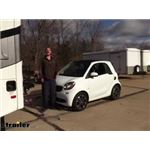

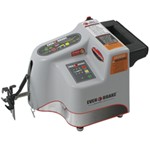
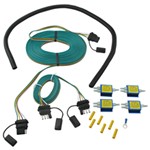
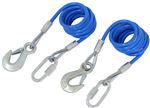
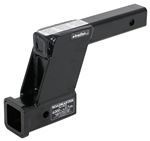



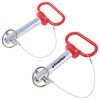










































































































Thank you! Your comment has been submitted successfully. You should be able to view your question/comment here within a few days.
Error submitting comment. Please try again momentarily.